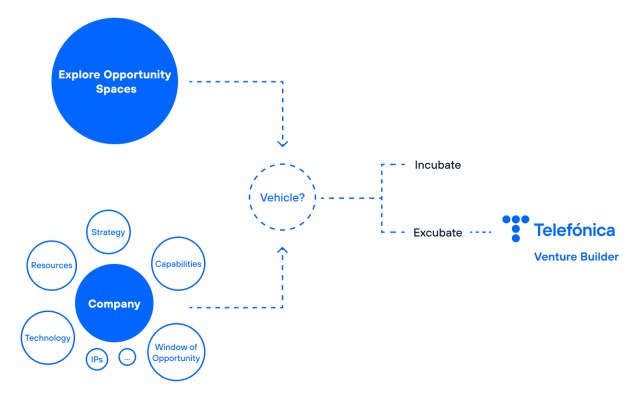What is a Venture Builder?
There are several types of Venture Builders, but what they have in common is that they follow a process and methodology to create new companies. They draw from ideas based on new business models, apply a strict validation process, and assemble teams that are well-suited for carrying out the business project. As is the case with Telefónica Venture Builder, they also tend to provide capital to the companies they create.
Why do I need a Venture Builder in a corporation?
Telefónica Venture Builder is a vehicle that creates and invests in start-ups as part of its corporate innovation strategy. It was born in early 2020 under the name Wayra Builder to complement existing investment vehicles and increase the value of Telefónica’s start-up portfolio. Its main purpose is to create technology start-ups based on innovative ideas with high market potential.
Telefónica created an area called Discovery at the beginning of the year, where all early-stage innovation initiatives are grouped together. Telefónica’s Venture Builder has been integrated into this new area since its inception. This has allowed us to have a space for innovation with two vehicles for exploring opportunities and implementing innovations: an internal vehicle and an external one. The Venture Builder is the external incubation or excubation vehicle (a term coined by Alceo Rapagna, the CEO of Innoleaps).
Thanks to these two incubation vehicles, we can determine the most appropriate innovation strategy to address an opportunity. Based on criteria such as alignment with the company’s strategy, availability of resources and capabilities, or window of opportunity, we can opt for an incubation or excubation strategy, whichever is more suitable.

Having an excubation vehicle in an early-stageinnovation organisation provides said organisation with the flexibility and autonomy to move initiatives from one vehicle to another. So, if it is initially decided that incubation is the best way to move forward with a specific opportunity, but it is later determined that it is more appropriate to proceed with excubation, we can switch from one vehicle to the other, and vice versa.
Moreover, having a Venture Builder gives us the possibility to increase the value of the company’s assets if incubation is not the most appropriate option:
- We can externally explore the viability of an idea, technology, etc. through the creation of a new company or spin-off (a model that promotes the open innovation paradigm) once it is decided that it is not going to be incubated or continued to be incubated, instead of leaving it on the shelf.
- We can also explore alliances for the creation of potential new companies that will allow us to address certain opportunities. By forming alliances with other Venture Builders, investors, or corporations from other industries, both parties can complement each other and lend their assets towards creating differential and sustainable competitive advantages for these start-ups.
This focus on leveraging Telefónica’s assets is precisely the main reason for recently changing the name of Wayra Builder to Telefónica Venture Builder.
One lesson we have learned from venture building is that a sustainable competitive advantage is crucial to a start-up’ s survival. Therefore, another important aspect of this approach is that the proximity of our Venture Builder to other early-stage innovation teams allows us to identify knowledge and technology we have within Telefónica that has the potential to generate differential and sustainable competitive advantages for the new companies created at the Builder.

What advantages does a Venture Builder of a corporation bring?
A Venture Builder of a corporation not only creates and invests in new companies but also leverages the company’s assets to improve the chances of success and viability of its start-ups, as well as to generate business and competitive advantages.
After the creation of the start-up, the new company’s team can rely on the support of the enterprise’s experts. For example, in the case of Telefónica Venture Builder, we offer the start-up advice regarding technology, design, product, business and finance during the two years following its creation or until the next round of investment.
In addition, if the start-up is at a more advanced stage and is a good fit, the corporation can boost its growth, not only as a potential start-up customer, but also by offering the start-up’s products and services to their own customers.
If the corporation offers a perks programme to its start-ups, as is the case with Telefónica, these new companies can access the corporation’s infrastructure and partners.
In conclusion, venture buildingcan be an innovation strategy that enables the corporation to offer an alternative vehicle for addressing its innovation opportunities and leveraging the company’s assets. Likewise, a Venture Builder in a corporation offers certain differential advantages to the start-ups created, which can improve their chances of success.











